Affinity-matured antibody with a disulfide bond in H-CDR3 loop.
Yoshida, M., Hanazono, Y., Numoto, N., Nagao, S., Yabuno, S., Kitagawa, Y., Sekiguchi, H., Ito, N., Azuma, T., Oda, M.(2024) Arch Biochem Biophys 758: 110068-110068
- PubMed: 38909835
- DOI: https://doi.org/10.1016/j.abb.2024.110068
- Primary Citation of Related Structures:
8YTN, 8YTO, 8YTP - PubMed Abstract:
Affinity maturation increases antigen-binding affinity and specificity of antibodies by somatic hypermutation. Various monoclonal antibodies against (4-hydroxy-3-nitrophenyl)acetyl (NP) were obtained during affinity maturation. Among them, highly matured anti-NP antibodies, such as E11 and E3, possess Cys96 H and Cys100 H in the complementarity-determining region 3 of the heavy chain, which would form a disulfide bond. In this study, we evaluated the effects of disulfide bonds on antigen binding by generating single-chain Fv (scFv) antibodies of E11 and its mutants, E11_C96K H /C100E H and E11_C96K H /C100Q H , and determined their antigen-binding thermodynamics and kinetics. The binding affinities of the Cys mutants were lower than that of E11 scFv, indicating that the disulfide bond contributed to antigen binding, especially for stable complex formation. This was also supported by the decreased affinity of E11 scFv in the presence of a reducing agent. The crystal structures of NP-free and NP-bound E11 scFvs were determined at high resolution, showing the existence of a disulfide bond between Cys96 H and Cys100 H , and the antigen recognition mechanism, which could be compared with those of other anti-NP antibodies, such as germline-type N1G9 and matured-type C6, as reported previously. These structures could explain the molecular basis of changes in antigen-binding affinity and thermal stability in the absence or presence of antigens. Small-angle X-ray scattering further showed a local conformational change in E11 scFv upon antigen binding in solution.
Organizational Affiliation:
Graduate School of Life and Environmental Sciences, Kyoto Prefectural University, 1-5 Hangi-cho, Shimogamo, Sakyo-ku, Kyoto, Kyoto, 606-8522, Japan.

















